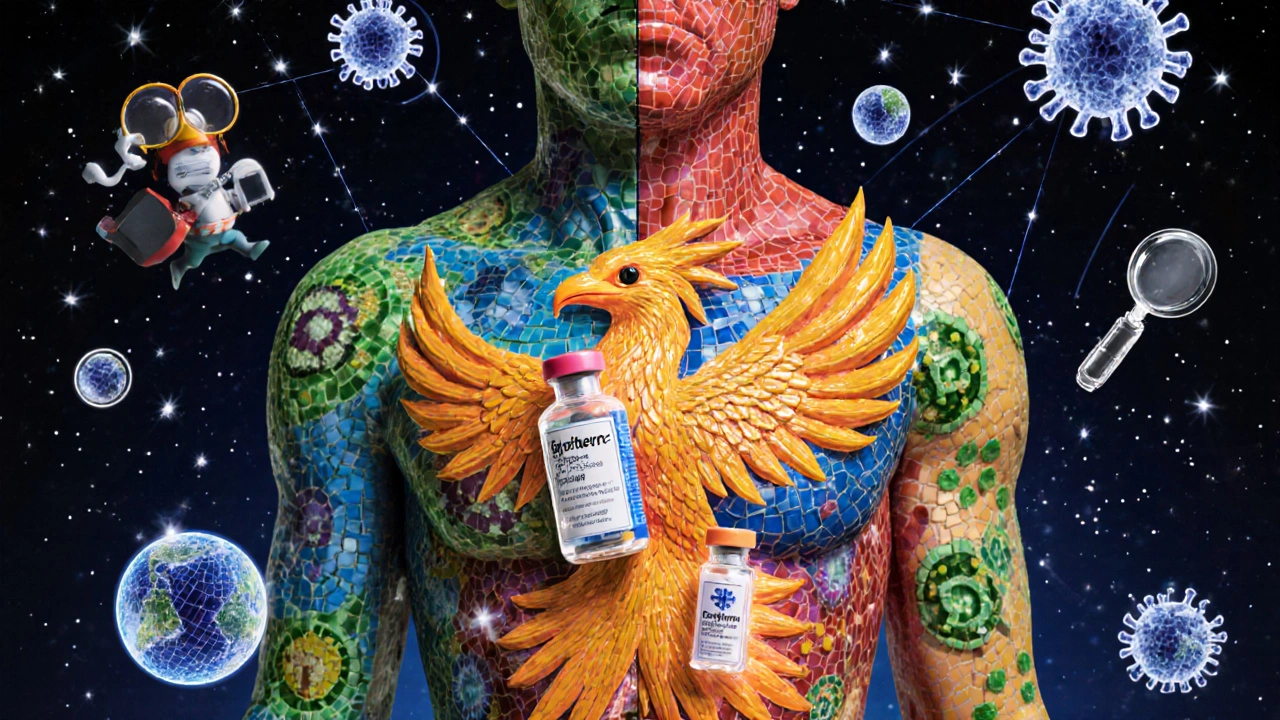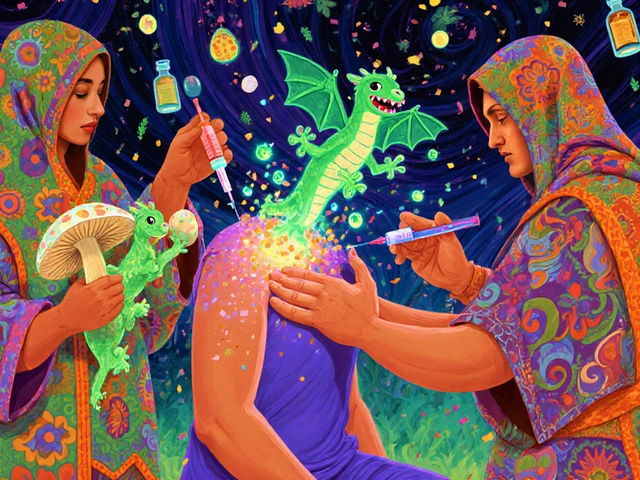When you get a vaccine, the last thing you expect is a serious reaction. Most people feel a sore arm or a mild fever, then move on with their day. But every now and then, someone has a scary reaction-hives, swelling, trouble breathing-and suddenly, everyone wonders: Is this safe?
How Rare Are Allergic Reactions to Vaccines?
Let’s get straight to the numbers. Out of every million vaccine doses given, about 1 to 2 people have a true anaphylactic reaction. That’s rarer than being struck by lightning. For the mRNA COVID-19 vaccines, the rate was slightly higher-around 5 to 11 cases per million doses-but still extremely low. Compare that to the risk of getting seriously ill from the diseases these vaccines prevent: measles, polio, flu, or COVID-19. The danger from the disease is hundreds to thousands of times greater than the risk from the vaccine.
Most reactions happen fast. About 71% of anaphylaxis cases show up within 15 minutes of getting the shot. That’s why clinics ask you to wait for 15 to 30 minutes after vaccination. If something happens, they’re ready. Epinephrine is on hand. Staff are trained. No one is left alone.
What Triggers These Reactions?
It’s not the virus or bacteria in the vaccine. Those are dead, weakened, or just genetic instructions. The real culprits are the tiny ingredients added to make the vaccine work or stay stable.
Polyethylene glycol (PEG) is one of the biggest suspects in recent cases. It’s used in the lipid nanoparticles that deliver mRNA in the Pfizer and Moderna COVID-19 vaccines. People with a known, severe allergy to PEG-rare as that is-were advised to talk to an allergist before getting these shots. But for most people, even those with food or drug allergies, PEG isn’t a problem.
Another ingredient sometimes blamed is yeast protein. It’s used to grow some vaccines, like hepatitis B and HPV. But studies show only about 15 possible cases ever linked to yeast out of 180,000 allergy reports in the U.S. system. Even then, it’s hard to prove yeast was the cause.
And what about eggs? For years, people with egg allergies were told to avoid flu shots. That changed after researchers studied over 4,300 egg-allergic individuals-including more than 650 who’d had life-threatening egg reactions-and found zero serious reactions after vaccination. Today, no special precautions are needed for egg-allergic people getting any flu vaccine.
Aluminum salts, used in many vaccines as an immune booster, don’t cause anaphylaxis. They can cause a slow, painful lump under the skin that lasts weeks, but that’s not an allergic reaction-it’s just local irritation.
Who’s Most Likely to Have a Reaction?
Women make up about 81% of reported allergic reactions after vaccines. The average age is around 40, but cases have been seen in babies as young as 3 months and adults over 80. People with a history of severe allergies-especially to foods, drugs, or insect stings-are more likely to have a reaction, but even then, the absolute risk remains tiny.
Most people who react have never had a reaction to a vaccine before. About 31% of those with allergic reactions had their first reaction after their very first dose of a vaccine. That means the body wasn’t sensitized by prior exposure-it’s a one-time event.

How Are Reactions Monitored?
The U.S. has one of the most detailed vaccine safety systems in the world: VAERS, the Vaccine Adverse Event Reporting System. Run by the CDC and FDA, it collects reports from doctors, patients, and vaccine makers about any health problem that happens after vaccination. It’s not perfect-it gets reports of things that aren’t even related to the vaccine-but it’s the first line of defense for spotting patterns.
When something unusual pops up, like a spike in cases of a certain reaction, experts dig deeper. They compare the number of reports to how many doses were given. They look at age, gender, timing, and vaccine type. They check if the reaction happened more often than expected by chance.
During the COVID-19 rollout, the CDC added v-safe, a smartphone tool that sent daily check-ins to people after vaccination. Over 3.6 million people used it. It helped catch early signals quickly and gave real-time reassurance to millions.
Europe has EudraVigilance. Other countries have similar systems. Together, they form a global safety net. Every major vaccine manufacturer is required to report serious reactions within 15 days. That’s not optional-it’s the law.
What Happens If You Have a Reaction?
If you develop hives, swelling of the lips or tongue, trouble breathing, or a sudden drop in blood pressure within minutes of getting a shot, it’s treated as an emergency. Epinephrine is given right away. That’s the only thing that stops anaphylaxis from becoming deadly.
Afterward, the reaction is reported to VAERS. Even if you feel fine after treatment, it still gets reported. That’s how we learn.
If you’ve had a confirmed anaphylaxis reaction to a vaccine, you won’t get that same vaccine again. But that doesn’t mean you can’t get other vaccines. Most vaccines don’t share the same ingredients. An allergist can help figure out which ones are safe.
For people with a history of severe allergies but no past vaccine reaction, the advice is simple: get vaccinated. Stay for the 30-minute observation period. Bring your epinephrine auto-injector if you have one. The benefit of protection far outweighs the risk.

Why Do People Still Worry?
Even with all the data, fear sticks around. One reason? Media. A single story about someone going into anaphylaxis after a vaccine makes headlines. The fact that 10 million people got the same shot with no issues? That doesn’t make the news.
Another reason? Misinformation. Social media posts claim vaccines are full of toxins or that allergic reactions are common. They’re not. The CDC says concerns about allergic reactions account for about 12% of vaccine hesitancy cases. That’s a lot of people avoiding life-saving shots because they think the risk is higher than it is.
Then there’s the legacy of the 1976 swine flu vaccine, which was linked to a rare nerve disorder called Guillain-Barré syndrome. That incident led to the creation of VAERS-and it still casts a long shadow. But today’s systems are far more advanced. We monitor more closely, respond faster, and understand the science better.
What’s Next for Vaccine Safety?
Scientists are working on ways to predict who might react before they even get the shot. One study, sponsored by the NIAID, is testing skin tests for PEG and other vaccine components. If it works, we might one day have a simple test to rule out risk.
Researchers are also looking at biomarkers-tiny signals in the blood-that could show when mast cells (the body’s allergy-triggering cells) are about to go off. If we can detect that early, we might be able to prevent reactions before they start.
The CDC’s 2023-2027 plan includes $28 million to improve data analysis for rare events. That means faster detection, smarter alerts, and better guidance for doctors and patients.
For now, the message is clear: vaccines are among the safest medical products we have. Allergic reactions are rare. Systems to catch them are strong. And the consequences of skipping vaccines? Much, much worse.


Been vaccinated like 5 times now, never had anything more than a sore arm. Honestly, the fear feels way out of proportion to the actual risk.
Let’s be real - we’re living in a post-truth epistemological nightmare where anecdotal horror stories from TikTok are weighted heavier than population-level epidemiological data. The very structure of modern media incentivizes the amplification of rare, emotionally charged events while systematically erasing the invisible, mundane triumphs of public health. Anaphylaxis at 5 per million? That’s statistically negligible. But you know what’s not negligible? The cognitive dissonance of a society that fears a needle more than a virus that’s already killed millions. We’ve weaponized fear into a religion, and vaccines are the heretics.
PEG is a well-characterized allergen, and its inclusion in lipid nanoparticles is a rational design choice - high solubility, low immunogenicity in most populations. The 1:200k reaction rate aligns with preclinical models. What’s more interesting is the lack of cross-reactivity with polysorbates in most cases, suggesting epitope specificity. Still, the clinical protocols around observation windows are robust and evidence-based.